[English] 日本語
 Yorodumi
Yorodumi- PDB-8i0q: Structure of beta-arrestin1 in complex with a phosphopeptide corr... -
+ Open data
Open data
- Basic information
Basic information
| Entry | Database: PDB / ID: 8i0q | ||||||
|---|---|---|---|---|---|---|---|
| Title | Structure of beta-arrestin1 in complex with a phosphopeptide corresponding to the human C-X-C chemokine receptor type 4, CXCR4 (Local refine) | ||||||
 Components Components |
| ||||||
 Keywords Keywords | SIGNALING PROTEIN/IMMUNE SYSTEM / GPCR / Arrestin / SIGNALING PROTEIN / SIGNALING PROTEIN-IMMUNE SYSTEM complex | ||||||
| Function / homology |  Function and homology information Function and homology informationV2 vasopressin receptor binding / alpha-1A adrenergic receptor binding / follicle-stimulating hormone receptor binding / TGFBR3 regulates TGF-beta signaling / sensory perception of touch / G alpha (s) signalling events / C-X-C motif chemokine 12 receptor activity / regulation of inositol trisphosphate biosynthetic process / follicle-stimulating hormone signaling pathway / protein phosphorylated amino acid binding ...V2 vasopressin receptor binding / alpha-1A adrenergic receptor binding / follicle-stimulating hormone receptor binding / TGFBR3 regulates TGF-beta signaling / sensory perception of touch / G alpha (s) signalling events / C-X-C motif chemokine 12 receptor activity / regulation of inositol trisphosphate biosynthetic process / follicle-stimulating hormone signaling pathway / protein phosphorylated amino acid binding / alpha-1B adrenergic receptor binding / positive regulation of macrophage migration inhibitory factor signaling pathway / Lysosome Vesicle Biogenesis / Specification of primordial germ cells / CXCL12-activated CXCR4 signaling pathway / myosin light chain binding / AP-2 adaptor complex binding / Ub-specific processing proteases / angiotensin receptor binding / MAP2K and MAPK activation / Golgi Associated Vesicle Biogenesis / myelin maintenance / C-X-C chemokine receptor activity / positive regulation of vasculature development / Cargo recognition for clathrin-mediated endocytosis / clathrin adaptor activity / Clathrin-mediated endocytosis / Signaling by ROBO receptors / negative regulation of interleukin-8 production / regulation of chemotaxis / Formation of definitive endoderm / C-C chemokine receptor activity / regulation of G protein-coupled receptor signaling pathway / Developmental Lineage of Pancreatic Acinar Cells / C-C chemokine binding / cysteine-type endopeptidase inhibitor activity involved in apoptotic process / arrestin family protein binding / G protein-coupled receptor internalization / mitogen-activated protein kinase kinase binding / Chemokine receptors bind chemokines / anchoring junction / Thrombin signalling through proteinase activated receptors (PARs) / dendritic cell chemotaxis / response to morphine / clathrin binding / stress fiber assembly / positive regulation of Rho protein signal transduction / cellular response to cytokine stimulus / pseudopodium / cell leading edge / negative regulation of interleukin-6 production / positive regulation of oligodendrocyte differentiation / positive regulation of receptor internalization / negative regulation of Notch signaling pathway / phototransduction / Binding and entry of HIV virion / positive regulation of insulin secretion involved in cellular response to glucose stimulus / regulation of cell adhesion / coreceptor activity / insulin-like growth factor receptor binding / neurogenesis / clathrin-coated pit / negative regulation of protein ubiquitination / GTPase activator activity / ubiquitin binding / positive regulation of protein ubiquitination / nuclear estrogen receptor binding / cell chemotaxis / phosphoprotein binding / calcium-mediated signaling / G protein-coupled receptor binding / brain development / G protein-coupled receptor activity / negative regulation of ERK1 and ERK2 cascade / response to virus / adenylate cyclase-modulating G protein-coupled receptor signaling pathway / endocytosis / positive regulation of protein phosphorylation / late endosome / protein transport / positive regulation of cold-induced thermogenesis / positive regulation of cytosolic calcium ion concentration / virus receptor activity / actin binding / cytoplasmic vesicle / ubiquitin-dependent protein catabolic process / regulation of apoptotic process / G alpha (i) signalling events / basolateral plasma membrane / dendritic spine / molecular adaptor activity / negative regulation of neuron apoptotic process / proteasome-mediated ubiquitin-dependent protein catabolic process / transmembrane transporter binding / postsynaptic membrane / early endosome / transcription coactivator activity / response to hypoxia / lysosome / positive regulation of ERK1 and ERK2 cascade Similarity search - Function | ||||||
| Biological species |    Homo sapiens (human) Homo sapiens (human) | ||||||
| Method | ELECTRON MICROSCOPY / single particle reconstruction / cryo EM / Resolution: 4.45 Å | ||||||
 Authors Authors | Maharana, J. / Sarma, P. / Yadav, M.K. / Banerjee, R. / Shukla, A.K. | ||||||
| Funding support |  India, 1items India, 1items
| ||||||
 Citation Citation |  Journal: Mol Cell / Year: 2023 Journal: Mol Cell / Year: 2023Title: Structural snapshots uncover a key phosphorylation motif in GPCRs driving β-arrestin activation. Authors: Jagannath Maharana / Parishmita Sarma / Manish K Yadav / Sayantan Saha / Vinay Singh / Shirsha Saha / Mohamed Chami / Ramanuj Banerjee / Arun K Shukla /   Abstract: Agonist-induced GPCR phosphorylation is a key determinant for the binding and activation of β-arrestins (βarrs). However, it is not entirely clear how different GPCRs harboring divergent ...Agonist-induced GPCR phosphorylation is a key determinant for the binding and activation of β-arrestins (βarrs). However, it is not entirely clear how different GPCRs harboring divergent phosphorylation patterns impart converging active conformation on βarrs leading to broadly conserved functional responses such as desensitization, endocytosis, and signaling. Here, we present multiple cryo-EM structures of activated βarrs in complex with distinct phosphorylation patterns derived from the carboxyl terminus of different GPCRs. These structures help identify a P-X-P-P type phosphorylation motif in GPCRs that interacts with a spatially organized K-K-R-R-K-K sequence in the N-domain of βarrs. Sequence analysis of the human GPCRome reveals the presence of this phosphorylation pattern in a large number of receptors, and its contribution in βarr activation is demonstrated by targeted mutagenesis experiments combined with an intrabody-based conformational sensor. Taken together, our findings provide important structural insights into the ability of distinct GPCRs to activate βarrs through a significantly conserved mechanism. #1:  Journal: Mol.Cell / Year: 2023 Journal: Mol.Cell / Year: 2023Title: Structure of beta-arrestin in complex with a phosphopeptide Authors: Maharana, J. / Sarma, P. / Yadav, M.K. / Banerjee, R. / Shukla, A.K. | ||||||
| History |
|
- Structure visualization
Structure visualization
| Structure viewer | Molecule:  Molmil Molmil Jmol/JSmol Jmol/JSmol |
|---|
- Downloads & links
Downloads & links
- Download
Download
| PDBx/mmCIF format |  8i0q.cif.gz 8i0q.cif.gz | 218.1 KB | Display |  PDBx/mmCIF format PDBx/mmCIF format |
|---|---|---|---|---|
| PDB format |  pdb8i0q.ent.gz pdb8i0q.ent.gz | 167.8 KB | Display |  PDB format PDB format |
| PDBx/mmJSON format |  8i0q.json.gz 8i0q.json.gz | Tree view |  PDBx/mmJSON format PDBx/mmJSON format | |
| Others |  Other downloads Other downloads |
-Validation report
| Summary document |  8i0q_validation.pdf.gz 8i0q_validation.pdf.gz | 1.2 MB | Display |  wwPDB validaton report wwPDB validaton report |
|---|---|---|---|---|
| Full document |  8i0q_full_validation.pdf.gz 8i0q_full_validation.pdf.gz | 1.2 MB | Display | |
| Data in XML |  8i0q_validation.xml.gz 8i0q_validation.xml.gz | 45.4 KB | Display | |
| Data in CIF |  8i0q_validation.cif.gz 8i0q_validation.cif.gz | 69 KB | Display | |
| Arichive directory |  https://data.pdbj.org/pub/pdb/validation_reports/i0/8i0q https://data.pdbj.org/pub/pdb/validation_reports/i0/8i0q ftp://data.pdbj.org/pub/pdb/validation_reports/i0/8i0q ftp://data.pdbj.org/pub/pdb/validation_reports/i0/8i0q | HTTPS FTP |
-Related structure data
| Related structure data |  35106MC  8go8C  8gocC 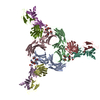 8gooC 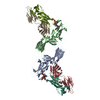 8gp3C  8i0nC 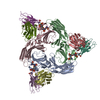 8i0zC 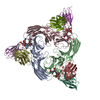 8i10C M: map data used to model this data C: citing same article ( |
|---|---|
| Similar structure data | Similarity search - Function & homology  F&H Search F&H Search |
- Links
Links
- Assembly
Assembly
| Deposited unit | 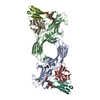
|
|---|---|
| 1 |
|
- Components
Components
| #1: Protein | Mass: 47088.508 Da / Num. of mol.: 2 Source method: isolated from a genetically manipulated source Source: (gene. exp.)   #2: Antibody | Mass: 25512.354 Da / Num. of mol.: 2 Source method: isolated from a genetically manipulated source Source: (gene. exp.)   #3: Antibody | Mass: 23435.064 Da / Num. of mol.: 2 Source method: isolated from a genetically manipulated source Source: (gene. exp.)   #4: Protein/peptide | Mass: 2380.530 Da / Num. of mol.: 2 / Source method: obtained synthetically / Source: (synth.)  Homo sapiens (human) / References: UniProt: P61073 Homo sapiens (human) / References: UniProt: P61073Has ligand of interest | Y | Has protein modification | Y | |
|---|
-Experimental details
-Experiment
| Experiment | Method: ELECTRON MICROSCOPY |
|---|---|
| EM experiment | Aggregation state: PARTICLE / 3D reconstruction method: single particle reconstruction |
- Sample preparation
Sample preparation
| Component |
| |||||||||||||||||||||||||||||||||||
|---|---|---|---|---|---|---|---|---|---|---|---|---|---|---|---|---|---|---|---|---|---|---|---|---|---|---|---|---|---|---|---|---|---|---|---|---|
| Molecular weight | Value: 0.19 MDa / Experimental value: YES | |||||||||||||||||||||||||||||||||||
| Source (natural) |
| |||||||||||||||||||||||||||||||||||
| Source (recombinant) |
| |||||||||||||||||||||||||||||||||||
| Buffer solution | pH: 7.4 | |||||||||||||||||||||||||||||||||||
| Buffer component |
| |||||||||||||||||||||||||||||||||||
| Specimen | Embedding applied: NO / Shadowing applied: NO / Staining applied: NO / Vitrification applied: YES | |||||||||||||||||||||||||||||||||||
| Vitrification | Instrument: LEICA EM GP / Cryogen name: ETHANE / Humidity: 90 % / Chamber temperature: 283.15 K / Details: Blotted for 3 seconds before plunging. |
- Electron microscopy imaging
Electron microscopy imaging
| Microscopy | Model: TFS GLACIOS |
|---|---|
| Electron gun | Electron source:  FIELD EMISSION GUN / Accelerating voltage: 200 kV / Illumination mode: FLOOD BEAM FIELD EMISSION GUN / Accelerating voltage: 200 kV / Illumination mode: FLOOD BEAM |
| Electron lens | Mode: BRIGHT FIELD / Nominal magnification: 46000 X / Nominal defocus max: 2500 nm / Nominal defocus min: 500 nm / Cs: 2.7 mm / Alignment procedure: COMA FREE |
| Specimen holder | Cryogen: NITROGEN |
| Image recording | Electron dose: 49.3 e/Å2 / Detector mode: COUNTING / Film or detector model: GATAN K3 (6k x 4k) / Num. of real images: 5637 |
| Image scans | Movie frames/image: 40 |
- Processing
Processing
| EM software |
| ||||||||||||||||||||||||||||
|---|---|---|---|---|---|---|---|---|---|---|---|---|---|---|---|---|---|---|---|---|---|---|---|---|---|---|---|---|---|
| CTF correction | Type: NONE | ||||||||||||||||||||||||||||
| Particle selection | Num. of particles selected: 3236193 | ||||||||||||||||||||||||||||
| Symmetry | Point symmetry: C2 (2 fold cyclic) | ||||||||||||||||||||||||||||
| 3D reconstruction | Resolution: 4.45 Å / Resolution method: FSC 0.143 CUT-OFF / Num. of particles: 86525 / Symmetry type: POINT | ||||||||||||||||||||||||||||
| Atomic model building | Protocol: FLEXIBLE FIT / Space: REAL | ||||||||||||||||||||||||||||
| Atomic model building | PDB-ID: 8GP3 Accession code: 8GP3 / Source name: PDB / Type: experimental model |
 Movie
Movie Controller
Controller









 PDBj
PDBj


















